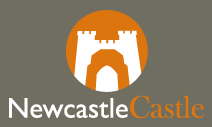Nine Men’s Morris
Nine Men’s Morris
Nine Men’s Morris is the name traditionally given in England to a very ancient boardgame sometimes also called “Mills” or “Merrills”. The game dates back at least to the days of the Roman Empire and is still played today. It was also very popular in medieval England, and boards are often found carved on stones used in building – excavations at the Castle revealed a large piece of building stone with a Nine Men’s Morris board carved onto it, which is currently on display at the Great North Museum Hancock. When these boards are discovered, they are sometimes carved so that they are placed vertically on the wall, making them impossible to play. Some archaeologists suggest that they were carved when the stones were being shaped, played with, and then the stones were used in building afterwards. Some however suggest some deeper meaning or significance to the symbol of the Nine Men’s Morris Board, linking it with architectural theory or use as a magical symbol to ward off evil spirits!
The game itself is a sort of advanced version of noughts and crosses. The board is a grid made of three concentric squares joined by a cross, with 24 intersections or ‘points.’ Each player starts with 9 pieces, which are called merrills or merels. The game has two phases. In the first phase, the players take turns putting their merels onto the board, placing them on the ‘point’. If they make a row of three of their own merels, that is called a ‘mill’, and they can capture and remove one of their opponent’s pieces. Once all the pieces have been placed on the board, the second phase starts.
In the second part of the game, unlike in noughts and crosses, you start to move your pieces. On your turn you can move one of your merels a single space along the lines of the board to an empty point. You can’t jump over other pieces, either your own or the other player’s. The goal is still to form mills or rows of three of your pieces along the lines of the board. It is perfectly OK, and a good strategy, to move a piece out of a mill and then back into the same row of three as many times as you like! Capturing an opponent’s piece in this phase is called ‘pounding’.
Once a player is reduced to just 3 pieces on the board, they are allowed to ‘fly’, which means they can move a piece to any vacant point on the board. Once a player is reduced to 2 pieces, the game is over, and the other player has won.
Game boards from the Mary Rose - Nine Men’s Morris on the left
Variations of the game with smaller or larger boards also exist, including 3 Men’s, 6 Men’s and 12 Men’s Morris. 3 Men’s Morris is basically identical to the game known today as tic-tac-toe or noughts and crosses and might represent the earliest form of the game.
The game seems to have been popular with medieval masons, soldiers and even peasants – Shakespeare refers to large Nine Men’s Morris boards outdoors on village greens. It has also been found carved on top of a barrel on the Mary Rose, Henry VIII’s flagship that sank in 1545. We can imagine the masons who built Newcastle Castle playing the game during breaks in their work, and probably the soldiers who garrisoned the Castle would also have played at Merels among many other games while they passed the long boring hours of guard duty.
Medieval Manuscript showing Nine Men’s Morris played with dice
The rules of the game may have been slightly different in medieval times, and probably differed from place to place and throughout the history of the game. Some medieval manuscripts show it being played with dice for example, and like most games there was probably also an element of gambling involved in certain times and places.
Board from Cresswell Crags in Derbyshire, carved alongside protective ‘witch marks’.
The other interesting thing about these boards is their possible symbolic use. The shape of the board has often suggested a kind of prison or trap to many people, with the lines leading into the empty square in the centre of the board. Some have suggested that this is the origin of the protective function of these boards when carved onto walls, drawing evil spirits into the centre and trapping them there where they cannot cause any mischief. One carving from Switzerland shows a board with a kind of small human figure placed at the centre of the board, which might be supposed to represent the spirit. Another reason to believe this theory is that the boards are often found carved among so called “witch marks”, which are protective symbols drawn or carved to provide protection against black magic.
The geometric shape of the board, and the fact that they are so often found associated with medieval stone carving, has led some people to suggest that they were part of a system of masonic symbolism where the size and ratios of the boards might be associated with the geometry necessary for the construction of the massive stone buildings of the Middle Ages. The comparative crudity of many of the carvings would tend to go against this idea though, and it may be that they survive so often in a ‘masonic’ context simply because boards carved on stone are much more likely to last the centuries than ones scratched into wood or just marked into the earth.
So why not draw yourself a board, grab some little pieces and have a go yourself? You’ll be taking part in an ancient tradition going back thousands of years! If you come to Newcastle Castle through the year you might catch sight of some of our guards playing a game of merels from time to time as well.




